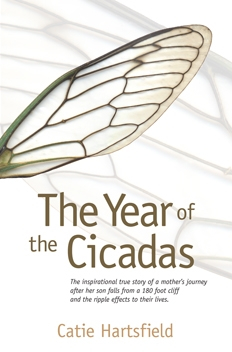The Year of the Cicadas
For Catie Hartsfield, the day that forever changed her life began in relatively ordinary fashion. Two of her three sons are on a hike, her daughter is shopping with Grandma Rose, and Catie is enduring the company of her critical father-in-law. The phone rings and Catie’s husband, Steve, answers it. The devastating news is every parent’s nightmare: There has been an accident. Their twenty-one-year-old son, Bryant, is clinging to life—the result of a fall from a 180-foot cliff.
This gut-wrenching, emotionally raw memoir about recovery, reinvention, and redemption will appeal to the reader who is familiar with the role of caretaker; an exhausting experience for which life seldom provides adequate preparation or coping strategies. Hartsfield asks, “Will I always compare the before and after, will I ever be able to accept his limits?”
Her book, The Year of the Cicadas, should be recommended reading for nursing staff and counselors who deal with victims of traumatic brain injury. Of particular importance are Hartsfield’s candid revelations of how such injuries affect the psyches, personal relationships, lingering guilt, and faith of those associated with patients.
Hartsfield holds nothing back in describing the anger, frustration, and extreme stress that Bryant’s accident puts on her marriage. “[Steve] is a planner. He lives with his planner in his pocket. There is no planning or time line with a brain injury.” The chronological account of Bryant’s grueling rehabilitation is a succession of ups and downs, raised expectations and crushing disappointments. The painful epiphany when the author realizes she’ll have to put her own dreams of career fulfillment on hold will resonate with anyone who feels they are victims of a cruel twist of fate. Particularly poignant is Hartsfield’s undisguised resentment that she has no one to blame for her son’s condition: “I have no one to take my anger out on, and no one to give me comfort. I, too, am a victim.”
The author’s decision to write the book in the present tense was a smart choice and keeps the suspense at a feverish pitch. The only encumbrances in maintaining momentum are the occasional shifts to the viewpoints of her husband and children. Unfortunately, these interesting sections, which are set in italicized type, dilute the book’s otherwise very strong focus and well-ordered structure.
While Hartsfield’s story is not a happy one—and sometimes casts Bryant in an unsympathetic light—it is an inspirational reminder that tragedy often has the transformative power to reshape one’s thinking, to redefine one’s values, and to help anyone rediscover strengths untapped during the blissfully predictable times.
Reviewed by
Christina Hamlett
Disclosure: This article is not an endorsement, but a review. The publisher of this book provided free copies of the book and paid a small fee to have their book reviewed by a professional reviewer. Foreword Reviews and Clarion Reviews make no guarantee that the publisher will receive a positive review. Foreword Magazine, Inc. is disclosing this in accordance with the Federal Trade Commission’s 16 CFR, Part 255.

